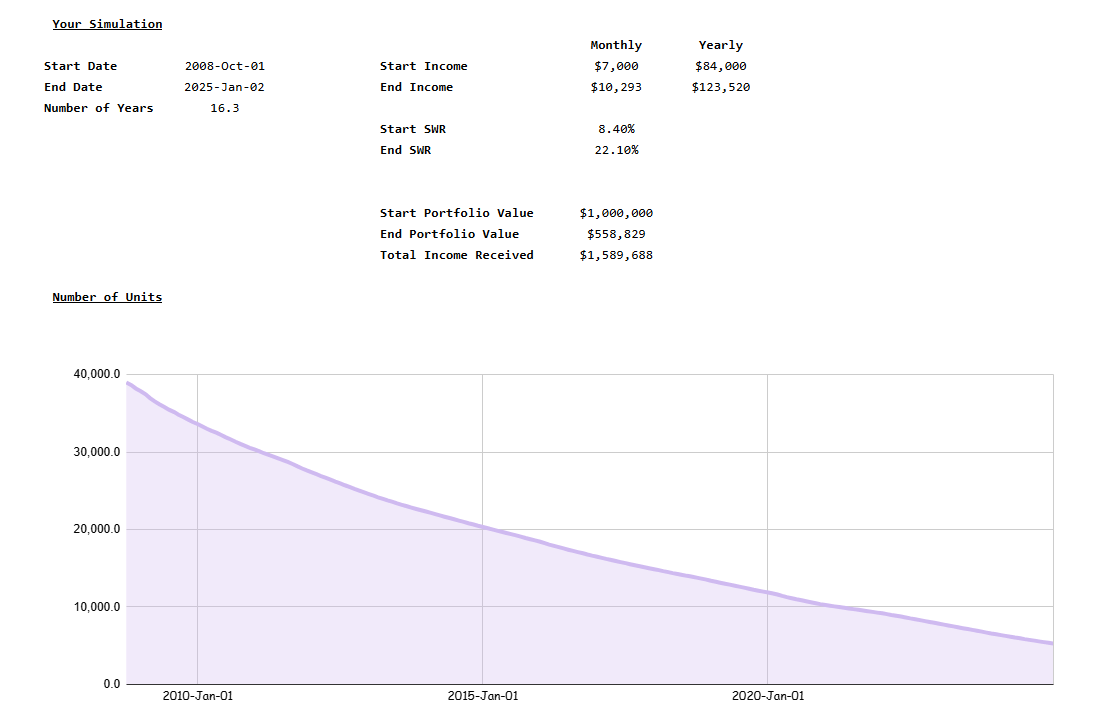I realize that I need a more intuitive way to simulate what does selling units spending from a risk portfolio look like.
This is especially after the conversation that I have about my friend’s income situation. Doing something that can illustrate this can be complicated or simple. I would feel the inertia to do it if I felt that it will take a lot of time.
But this time I dug in to create something.
I would like to take some time to explain how this Simulating Portfolio Spending spreadsheet work.
Why Should You be Interested in This Spreadsheet?
Here are a few reasons:
- If you wonder how a fund/portfolio will look like if you keep selling units to get income.
- Feel like if you sell units, your fund will go to shit very soon.
- Want to see if Kyith is right that you can get income, but the portfolio can grow even more.
- Want to test and see if start spending $80,000 inflation-adjusted income out of a $1 million portfolio will kill the portfolio.
- Understand important portfolio income concepts.
How to Access The Simulating Portfolio Spending Spreadsheet.
If you click on this link, you can duplicate a copy of my spreadsheet and use it yourself.
There are currently three sheets:
- Simulation
- Monthly
- Inception to Feb 2025.
You will only need to focus on Simulation sheet.
There are three things that you need to input that is all:

- You can choose when you wish to start the simulation. This simulation uses the actual Net Asset Value (NAV) per unit of the fund so we are able to simulate when you wish to simulate the start of your “retirement/FI date” to start spending from the portfolio.
- You specify how much that is in your portfolio for a start. In this case, we start with $1 million.
- You specify how much is the starting monthly income.
That is it and you can see the result.
The Fund We Are Simulating – L&G Russell 2000 US Small Cap Quality UCITS ETF (RTWO)
I chose an obscure US small cap quality ETF because I want to start this off with a ETF that is
- Less well known.
- UCITS
- Accumulating (does not payout income distribution) so it’s NAV reflects the total return from a month by month basis.
The RTWO is listed on the London Stock Exchange (LSE) and tracks the Russell 2000 0.4 Quality Target Exposure Factor Net Tax Index.
RTWO is incepted in Sep 2008, which means that it has roughly 16 years of real market returns.
This is not an index. This is an actual ETF.
Every time I got to entertain people with different opinions and one of them is “You always use all these historical indexes, how we know when we cannot invest in these indexes??”
Well, so this is an ETF that selects a certain sub-segment of small caps that they determine has higher quality on a periodic basis, selling out those that periodically fell out of the screens.
The annualized compounded average growth is 9.15% p.a. since inception till Jan 2025. There are 196 months in this 16 years period.
We are Using Monthly US CPI
For each corresponding month, I collated the monthly CPI. The inflation in this 16.3 years is 2.39% p.a.
With this we are able to simulate the income adjusting for inflation.
We will adjust the income based on inflation.
Let’s Go Through an $36,000 yearly Inflation-Adjusted Income from a $1 Million portfolio.
Let’s start and imagine we put in our money ($1 million) before 1-Oct-2008 and we want to see after 16.3 years, will we run out of money.
The main table shows the simulation:


We are simulating as if you spend with $3000 in the first month then we adjust the income by the month’s inflation rate. Notice that the monthly income starts going up over time and reaches $3,211 in 2013. We start with 39,133 units of RTWO bought at $25.477.
The units starts going down as we sell more units, but the NAV per unit goes up from $25.477 to $36.09.
To help you understand things better, I crafted a summary report right of the datatable:


You can see that the income grew from $3000 monthly to $4,411 monthly after 16 years. By spending $36k on $1 million, the initial SWR (safe withdrawal rate) is 3.6% and when we end this the SWR actually fell to 2.02% based on the income in 2025 ($4,411) and the portfolio value then ($2.6 million).
If the end value is $2.6 million, which is positive it means you don’t run out of money. In fact, your money doubled and more and you get $681k in total income over this 16 years.
This is a positive sequence.


You can take a look at each of the charts to see how the units, monthly income, NAV per unit change over the period.
I won’t spoil your fun.
Now let’s try something else.
Let’s Go Through an $84,000 yearly Inflation-Adjusted Income from a $1 Million portfolio.
We do something Kyith tell us never to do. Spend $7,000 monthly in an inflation adjusted way on a $1 million portfolio.
Even worse, instead of spending income, sell units.
That is nearly a 8.4% initial withdrawal rate.


Well you really lose a big chunk of the units. Your income went up from $7000 monthly to $10,293 monthly and spent a total of $1.5 million during this period.
The portfolio still left with $558k.
Given that the income has climbed to $10k monthly, I wonder if the fund can last another five years.
Simulate Before a Big Drop.
You can shift the date around to see how the portfolio perform if all you have is $1 million and you decide to spend $36,000 in that year.
A good period might be before the 2018 end of the year drop.


Do star at the numbers if you can. Sometimes it is hard to describe portfolio volatility and even tougher to visualize the volatility while spending from the portfolio.
I think this might be one way to make sense of the psychological aspect about spending.
Hope that you find this useful.
I would most likely make use of this template to create another portfolio spending simulation but with another fund with longer history.
—
If you want to trade these stocks I mentioned, you can open an account with Interactive Brokers. Interactive Brokers is the leading low-cost and efficient broker I use and trust to invest & trade my holdings in Singapore, the United States, London Stock Exchange and Hong Kong Stock Exchange. They allow you to trade stocks, ETFs, options, futures, forex, bonds and funds worldwide from a single integrated account.
You can read more about my thoughts about Interactive Brokers in this Interactive Brokers Deep Dive Series, starting with how to create & fund your Interactive Brokers account easily.


